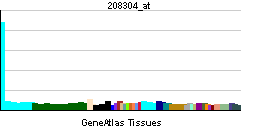CCR3 (gene)
| Chemokine (C-C motif) receptor 3 | |||||||||||
|---|---|---|---|---|---|---|---|---|---|---|---|
| Identifiers | |||||||||||
| Symbols | CCR3 ; CC-CKR-3; CD193; CKR3; CMKBR3; MGC102841 | ||||||||||
| External IDs | Template:OMIM5 Template:MGI HomoloGene: 20436 | ||||||||||
| |||||||||||
| RNA expression pattern | |||||||||||
 | |||||||||||
| More reference expression data | |||||||||||
| Orthologs | |||||||||||
| Template:GNF Ortholog box | |||||||||||
| Species | Human | Mouse | |||||||||
| Entrez | n/a | n/a | |||||||||
| Ensembl | n/a | n/a | |||||||||
| UniProt | n/a | n/a | |||||||||
| RefSeq (mRNA) | n/a | n/a | |||||||||
| RefSeq (protein) | n/a | n/a | |||||||||
| Location (UCSC) | n/a | n/a | |||||||||
| PubMed search | n/a | n/a | |||||||||
Chemokine (C-C motif) receptor 3, also known as CCR3, is a human gene.[1]
CCR3 has also recently been designated CD193 (cluster of differentiation 193).
The protein encoded by this gene is a receptor for C-C type chemokines. It belongs to family 1 of the G protein-coupled receptors. This receptor binds and responds to a variety of chemokines, including eotaxin (CCL11), eotaxin-3 (CCL26), MCP-3 (CCL7), MCP-4 (CCL13), and RANTES (CCL5). It is highly expressed in eosinophils and basophils, and is also detected in TH1 and TH2 cells, as well as in airway epithelial cells. This receptor may contribute to the accumulation and activation of eosinophils and other inflammatory cells in the allergic airway. It is also known to be an entry co-receptor for HIV-1. This gene and seven other chemokine receptor genes form a chemokine receptor gene cluster on the chromosomal region 3p21. Alternatively spliced transcript variants encoding the same protein have been described.[1]
See also
References
Further reading
- Choe H, Martin KA, Farzan M; et al. (1998). "Structural interactions between chemokine receptors, gp120 Env and CD4". Semin. Immunol. 10 (3): 249–57. PMID 9653051.
- Marone G, Florio G, Petraroli A, de Paulis A (2001). "Dysregulation of the IgE/Fc epsilon RI network in HIV-1 infection". J. Allergy Clin. Immunol. 107 (1): 22–30. PMID 11149986.
- Marone G, Florio G, Triggiani M; et al. (2001). "Mechanisms of IgE elevation in HIV-1 infection". Crit. Rev. Immunol. 20 (6): 477–96. PMID 11396683.
- Ruibal-Ares BH, Belmonte L, Baré PC; et al. (2004). "HIV-1 infection and chemokine receptor modulation". Curr. HIV Res. 2 (1): 39–50. PMID 15053339.
- Post TW, Bozic CR, Rothenberg ME; et al. (1995). "Molecular characterization of two murine eosinophil beta chemokine receptors". J. Immunol. 155 (11): 5299–305. PMID 7594543.
- Combadiere C, Ahuja SK, Murphy PM (1995). "Cloning and functional expression of a human eosinophil CC chemokine receptor". J. Biol. Chem. 270 (28): 16491–4. PMID 7622448.
- Ponath PD, Qin S, Ringler DJ; et al. (1996). "Cloning of the human eosinophil chemoattractant, eotaxin. Expression, receptor binding, and functional properties suggest a mechanism for the selective recruitment of eosinophils". J. Clin. Invest. 97 (3): 604–12. PMID 8609214.
- Kitaura M, Nakajima T, Imai T; et al. (1996). "Molecular cloning of human eotaxin, an eosinophil-selective CC chemokine, and identification of a specific eosinophil eotaxin receptor, CC chemokine receptor 3". J. Biol. Chem. 271 (13): 7725–30. PMID 8631813.
- Combadiere C, Ahuja SK, Murphy PM (1996). "Cloning and functional expression of a human eosinophil CC chemokine receptor". J. Biol. Chem. 271 (18): 11034. PMID 8631926.
- Daugherty BL, Siciliano SJ, DeMartino JA; et al. (1996). "Cloning, expression, and characterization of the human eosinophil eotaxin receptor". J. Exp. Med. 183 (5): 2349–54. PMID 8642344.
- Choe H, Farzan M, Sun Y; et al. (1996). "The beta-chemokine receptors CCR3 and CCR5 facilitate infection by primary HIV-1 isolates". Cell. 85 (7): 1135–48. PMID 8674119.
- Ponath PD, Qin S, Post TW; et al. (1996). "Molecular cloning and characterization of a human eotaxin receptor expressed selectively on eosinophils". J. Exp. Med. 183 (6): 2437–48. PMID 8676064.
- Samson M, Soularue P, Vassart G, Parmentier M (1997). "The genes encoding the human CC-chemokine receptors CC-CKR1 to CC-CKR5 (CMKBR1-CMKBR5) are clustered in the p21.3-p24 region of chromosome 3". Genomics. 36 (3): 522–6. doi:10.1006/geno.1996.0498. PMID 8884276.
- Heath H, Qin S, Rao P; et al. (1997). "Chemokine receptor usage by human eosinophils. The importance of CCR3 demonstrated using an antagonistic monoclonal antibody". J. Clin. Invest. 99 (2): 178–84. PMID 9005985.
- He J, Chen Y, Farzan M; et al. (1997). "CCR3 and CCR5 are co-receptors for HIV-1 infection of microglia". Nature. 385 (6617): 645–9. doi:10.1038/385645a0. PMID 9024664.
- Daugherty BL, Springer MS (1997). "The beta-chemokine receptor genes CCR1 (CMKBR1), CCR2 (CMKBR2), and CCR3 (CMKBR3) cluster within 285 kb on human chromosome 3p21". Genomics. 41 (2): 294–5. doi:10.1006/geno.1997.4626. PMID 9143512.
- Forssmann U, Uguccioni M, Loetscher P; et al. (1997). "Eotaxin-2, a novel CC chemokine that is selective for the chemokine receptor CCR3, and acts like eotaxin on human eosinophil and basophil leukocytes". J. Exp. Med. 185 (12): 2171–6. PMID 9182688.
- Alkhatib G, Berger EA, Murphy PM, Pease JE (1997). "Determinants of HIV-1 coreceptor function on CC chemokine receptor 3. Importance of both extracellular and transmembrane/cytoplasmic regions". J. Biol. Chem. 272 (33): 20420–6. PMID 9252350.
- Pakianathan DR, Kuta EG, Artis DR; et al. (1997). "Distinct but overlapping epitopes for the interaction of a CC-chemokine with CCR1, CCR3 and CCR5". Biochemistry. 36 (32): 9642–8. doi:10.1021/bi970593z. PMID 9289016.
- Sallusto F, Mackay CR, Lanzavecchia A (1997). "Selective expression of the eotaxin receptor CCR3 by human T helper 2 cells". Science. 277 (5334): 2005–7. PMID 9302298.
External links
- CCR3+protein,+human at the US National Library of Medicine Medical Subject Headings (MeSH)
This article incorporates text from the United States National Library of Medicine, which is in the public domain.
| Stub icon | This membrane protein–related article is a stub. You can help Wikipedia by expanding it. |